There are a few things you can do to give a polished finish to any plastic component, no matter how it's been shaped or cut.
Before you get started, here are some of the things you're going to need:
A selection of files
A metal rule
A range of wet and dry paper
A wax polishing wheel and some wax
A blowtorch
Some hot work gloves, apron and goggles
And finally, a face shield
Like all abrasive processes, the idea is to start with more abrasive tools and materials, and then, step by step, use less abrasive techniques until you're happy with the finish.
Flatten rough edges by cross-filing. Push the file across and along the surface until its feels flat to touch.
Keep the file flat to the workbench to make sure the edges are square.
To file a curve, start with the file flat on one edge, then run it along the curve, finishing with it flat on the other edge.
At this stage, you will have marks from the filing which you should remove with a steel rule or scraper.
To get a good near-polished finish, you will now need to use wet and dry paper.
Wet the paper with a little water to reduce friction.
Start with a 280 grit, then move on to 600 grit, and finally 1200 grit.
Remember, that the higher the grit number, the finer the finish.
After this the surface should feel very smooth.
To achieve a high polish finish you now have two options.
The most common way is to use a wax polishing wheel and you'll need your goggles or face shield and gloves for this.
Apply the wax to the cloth wheel.
Then working from the centre towards the corners, use the machine to polish the edges.
Be careful here not to snag the cloth on the corners.
Re-apply the wax to the wheel every 30 seconds or so to avoid excessive friction which could melt the edges.
If you are polishing high impact polystyrene, you will need to take extra care. It has a much lower softening point than acrylic and so is more likely to melt with excessive friction.
Finally, remove any remaining wax with the polishing mop.
You can get a really clear glass-like finish by flame polishing your plastic edges.
For this process, you will need to put on your hot work protective gloves, apron and a face shield.
This option will only work for acrylic. Flame polishing cannot be used to finish high impact polystyrene.
We are using a blowtorch here but you can get the same result with a brazing torch or an oxy acetylene torch. It is a very quick and simple process and gives a great finish to your plastic.
Video summary
This short film explains the processes used to take a rough-cut plastic edge or surface and give it a professional, polished finish.
It lists the tools students will need and guides them through the process step-by step.
Teacher Notes
Points for discussion
- When has one process been completed well enough to move on to the next?
- How do you achieve quality control in small-scale projects? How would that differ in large scale, commercial manufacturing?
- In what ways are these processes similar to finishing metal or wood?
- When might you choose flame polishing over buffing and polishing with a polishing mop or wheel?
- How might toothpaste be useful as a product for helping to finish plastics? It can be!
- Would you apply a surface or edge finish to a piece of plastic before or after line bending or drape forming it? Why?
Suggested activities
- As an FPT, have a competition to create the best polished edge on a rough-cut piece of acrylic.
- This process can be used to finish a huge range of items which students choose for projects, for example mobile phone holders, personalised bag tags, desk tidies, boombox housings, etc.
- This process can be adapted to provide a professional finish for a huge range of products and components for KS4 projects.
Suitable for teaching design and technology (D&T) at KS3/KS4 in England, Wales and Northern Ireland, and 3rd/4th levels in Scotland.
Finishing wood. video
This short film explains the process of finishing wood to achieve a professional look.

Screwing components together. video
This short film explains how to use screws, nuts and bolts to fix components together.

Finishing metal. video
This short film explains the process of finishing metal to achieve a professional look.
